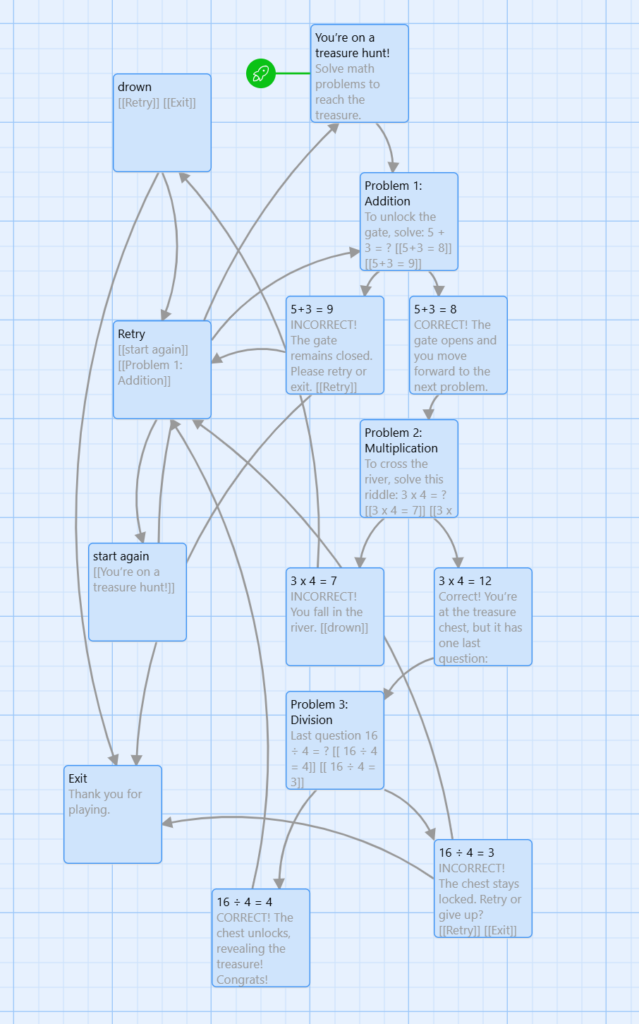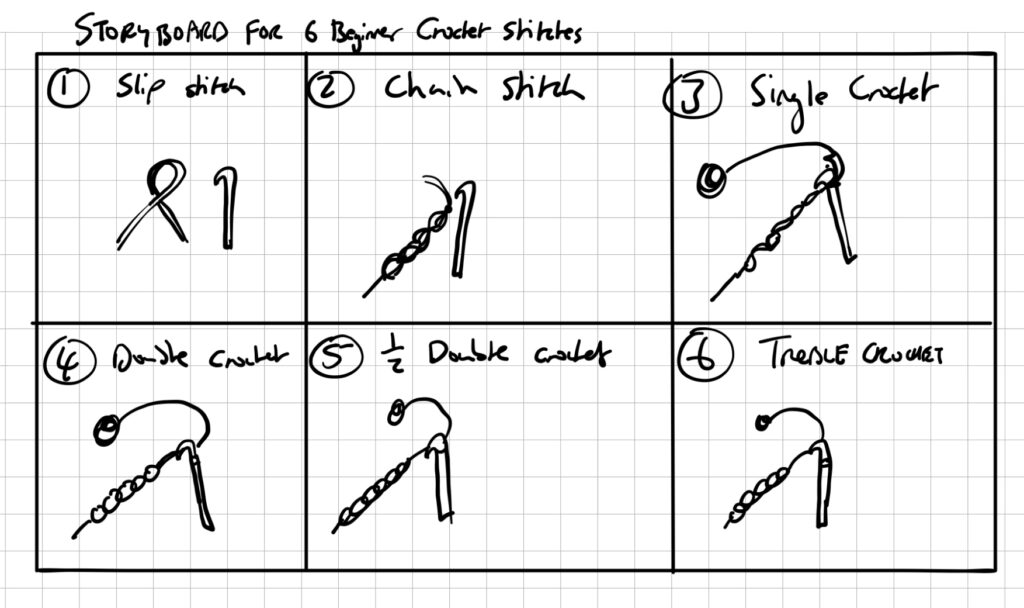Exploring Twine

A link to my Twine Branched Story: https://rena711.github.io/Twine-treasure-hunt/
I decided to create a math treasure hunt in Twine. I found it to be a fun way to combine storytelling with interactive learning. The project involved building a narrative where learners solve math problems at each checkpoint to unlock new paths and ultimately reach the treasure. This approach offers learners the opportunity to practice math skills in a low-pressure environment.
My video teaching the 6 Basic Crochet Stitches
I’ve been learning how to crochet, so I thought this would be a fun way to see how much I remembered and create an opportunity for others to learn too.
Crochet Tutorial: Six Basic Crochet Stitches Script
Hi everyone,
Today I’ll be teaching the six basic crochet stitches. These stitches can be used for just about any beginner project. So let’s get started!
1. Slip Stitch
The first stitch I’ll be teaching is called the slip stitch. This is how you would usually begin a crochet project:
- Start by making a loop.
- Bring the yarn through the loop and insert your crochet hook into it.
- Pull on both ends of the yarn to tighten it.
2. Chain Stitch
Next is the basic chain stitch. Here’s how it’s done:
- Yarn over once.
- Pull the bottom yarn over the top one.
- Repeat: yarn over once and pull the bottom one over.
- Keep repeating: yarn over once and pull the bottom one over.
And that is the chain stitch!
3. Single Crochet
The next stitch is called the single crochet. Here’s how to do it:
- Start with the chain stitch from earlier.
- Insert the crochet hook into the second chain stitch.
- Yarn over and pull through the first loop.
- Yarn over again and pull through the bottom two loops.
By the end, there should be one loop left on the crochet hook.
Let me show you again:
- Insert the crochet hook into the next chain stitch.
- Yarn over, pull through the first loop.
- Yarn over again and pull through the next two loops.
And that is a single crochet!
4. Half Double Crochet
Next, we have the half double crochet. This stitch is a bit different and creates a slightly taller stitch:
- Yarn over and insert the hook into the second chain stitch.
- Yarn over again and pull through the stitch. You should now have three loops on your hook.
- Yarn over once more and pull through all three loops on the hook.
Let’s do that again:
- Yarn over, insert the hook into the next chain stitch, and yarn over again.
- Pull through the stitch so that there are three loops on your hook.
- Yarn over again and pull through all three loops on the hook.
And that is the half double crochet!
5. Double Crochet
The next stitch I’ll demonstrate is called the double stitch. Here’s how it’s done:
- Yarn over and insert the crochet hook into the second chain stitch.
- Yarn over again and bring the crochet hook through the next stitch.
- Yarn over and pull through the first two loops on the crochet hook.
- Yarn over again and pull through the remaining two loops.
And that is a double stitch!
Let me repeat:
- Yarn over, insert the hook into the next chain stitch, and yarn over again.
- Pull through the first two loops.
- Yarn over, pull through the next two loops.
And that’s the double stitch!
6. Treble Crochet
Now, let’s move on to the treble crochet. Here’s how you do it:
- Yarn over twice.
- Insert the hook into the next chain stitch.
- Yarn over and pull through the first loop.
- Yarn over again and pull through the next two loops.
- Yarn over once more and pull through the next two loops.
- Finally, yarn over again and pull through the last two loops.
And that’s a treble crochet! Let me show you again:
- Yarn over twice, insert the hook into the next chain stitch, and yarn over.
- Pull through the first loop.
- Yarn over, pull through the next two loops.
- Yarn over again, pull through the next two loops.
- Yarn over once more, pull through the final two loops.
And that’s it for the treble crochet!

Reflection on Readings
In this week’s readings, I found Richard Turere’s TED Talk about his invention to protect livestock from lions really interesting. His use of a personal story (Technique 2) was inspiring. By sharing his challenges and how he overcame them, he made the story relatable. Also, his use of simple visuals to support his narrative (Technique 1) made his talk more engaging. His talk helped demonstrate how storytelling can make even complex topics accessible and meaningful.
Capturing Video Beyond the Screencast
Capturing video away from the screencast was both challenging and rewarding. On one note, it allowed me to incorporate physical demonstrations and real-world visuals, making the content more engaging. Setting up proper lighting and framing shots added a professional touch that made the final product more interesting.
However, I encountered challenges with sound quality and finding the right angles to clearly show my hands for the stitches. Editing the footage to align with my script was also time-consuming. If I were to do this again, I would invest more time in pre-planning and include a detailed storyboard.
Wow, I love how creative you’ve been with both the math treasure hunt and the crochet tutorial! The treasure hunt sounds like such a fun way to make math engaging, and your step-by-step crochet guide is super clear—I’ve always wanted to try it! Filming beyond a screencast can be tricky, but it sounds like you handled it well. Great job!